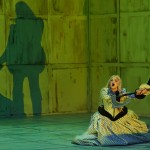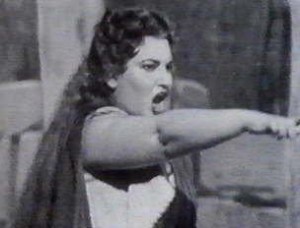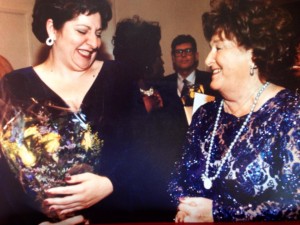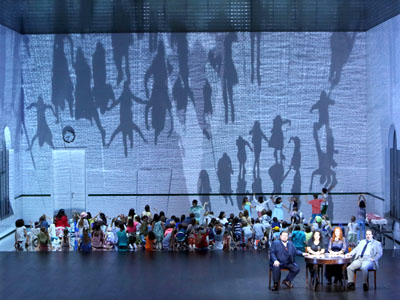by Sedgwick Clark
British composer Benjamin Britten was celebrating his 50th birthday on November 22, 1963, when news came of the assassination of President John F. Kennedy. Fifty years later, we in New York’s major concert halls were somehow able to salve our memories of that world-altering tragedy and at the same time honor the composer’s centennial with outstanding performances of three of his most attractive works. Carnegie Hall featured a semi-staged concert of his most popular opera, Peter Grimes, with David Robertson conducting the St. Louis Symphony, and at Avery Fisher Hall, Alan Gilbert led the New York Philharmonic in the Serenade for Tenor, Horn, and Strings and the rarely played Spring Symphony for soloists, chorus, and orchestra.
As I began learning about classical music in college in the ’60s, British Decca was systematically recording Britten’s works with the composer as conductor, just as Columbia had been doing with Stravinsky. Along with Stravinsky’s recordings, I also bought Britten’s as well as recommended versions of his music by other conductors. The first was Carlo Maria Giulini’s EMI release with the Philharmonia Orchestra of the Grimes Four Sea Interludes and Young Person’s Guide to the Orchestra; those performances are still unsurpassed, to my ears, for warmth and expressiveness. When I finally got around to hearing the composer’s recording of the complete opera, I was surprised to find that the Interludes seemed dry and perfunctory in comparison.
But the problem seems deeper to me than the performances: Most of Britten’s music leaves me cold. I was afraid to say so at the time (after all, so many eminent critics praised his works). The conclusion is unavoidable that, for all the evident craftsmanship and striking instrumentation, the music remains emotionally removed to me, like much of Brahms. Dale Harris pinpointed my reservations in an article entitled “Britten’s Operas: Will They Survive?” in the March 1979 issue of Keynote magazine. After explaining why he thinks Peter Grimes, “for all its weaknesses, is likely to survive,” Harris continues:
“Throughout the composer’s operatic oeuvre there is a persistent element of inhibition, a terror—the word, I feel, is not too strong—of emotional commitment. . . . Britten’s essential subject is usually said to be the destruction of innocence, and, certainly, he showed throughout his career a real fascination with a whole succession of victims—among them, Grimes, Billy Budd, Lucretia, Miles and Flora, the haunted children of The Turn of the Screw, and Owen Wingrave. No less central to his creative sensibility, however, is another and related subject: the frustration of love, a theme which surfaces importantly in Peter Grimes, Gloriana, Death in Venice, and A Midsummer Night’s Dream and which one could conclude helped to attract him to certain plot situations in the first place. Yet there is hardly a trace in any of these works of genuine amorous passion, the existence of which, I submit, we must be persuaded of before we can believe in its frustration. . . .”
I have warmed most to Britten’s earliest works, up to around 1950—and also to the War Requiem (1962), which I have found an emotionally devastating piece, most notably under Mstislav Rostropovich and Gianandrea Noseda. It is a favorite of Kurt Masur; he performed it twice while music director of the New York Philharmonic and recorded it for Teldec. Robert Spano and the Atlanta Symphony are set for a Carnegie Hall performance on April 30. If Britten had written nothing else, he would be acknowledged a great composer.
New York’s Bow to Britten’s Centennial
Peter Grimes (1946) was the first opera I ever saw live, 45 years ago at the Met; Jon Vickers sang the title role and Colin Davis conducted. Not bad. The St. Louis Symphony’s Grimes struck me as no less seaworthy, with the opera’s sublimely atmospheric Sea Interludes and Passacaglia all the more vivid emanating directly from the stage rather than from an opera pit. Some of Robertson’s tempos struck me as overly brisk: Mrs. Sedley’s warning lacked dread, and the townspeople’s bidding of “Good night, good people, good night” was short on affection. Anthony Dean Griffey’s Grimes may have lacked the sheer, unhinged danger of Vickers’s characterization—the mad scene, for instance, went for little, and it was difficult to imagine this warm bear of a man abusing his apprentices—but his singing was unfailingly eloquent, movingly capturing the character’s bewildered humanity. Susanna Phillips’s stalwart Ellen Orford was, for once, not a wimpy schoolmistress. Alan Held’s gruff bass-baritone gave Captain Balstrode an authority I don’t recall before. Actually, the entire cast bore a welcome seriousness that, for me, surpassed the cartoonish performances of the townspeople at the Met over the years.
Alan Gilbert’s Britten double header was one of his most successful nights on the Philharmonic podium. I arrived too late for the Serenade (1943) on Thursday evening (11/21) but stuck around for the Spring Symphony (1948-49) and returned to hear both works on Saturday night. The originally scheduled tenor had fallen ill, and his replacement at the latter performance was none other than Anthony Dean Griffey, the St. Louis Grimes the night before at Carnegie, who proceeded to sing no less superbly in both works. The Philharmonic’s principal horn player, Philip Myers, performed on a natural horn in the Prologue and Epilogue as Britten directs. He reportedly had a spotty night in the Serenade on Thursday, but on Saturday he was at the top of his game, negotiating Britten’s wide intervallic leaps and expressive dynamic contrasts with apparent ease and delivering astonishing diminuendos to ppp. The ebullient Spring Symphony, consisting of 12 poems about the spring season ranging in date from the 13th century to the 20th, had not been played by the Philharmonic since 1963 under Bernstein. Another 50-year lapse would be inexcusable.
Decca’s Complete Britten
Today’s crop of British critics (and many American ones) consider Britten his country’s greatest composer. I remain firmly in the Vaughan Williams camp. But I’ll have plenty of time to reassess the music and recordings in Decca’s recent 65-CD release of Britten’s complete works, consisting of all the Decca material plus recordings from 19 other labels to make the set complete.
In addition, four bonus CDs include a series of newly conducted interviews with surviving musicians who worked closely with Britten, historic recordings and rarities, and Britten’s rehearsals at the recording sessions for the War Requiem, which itself has been newly re-mastered this year from the analog master tapes. The set also features a DVD of Tony Palmer’s film on the making of the 1967 recording of The Burning Fiery Furnace, chosen specifically for its insight into the Britten-Decca recording relationship and the working methods of producer John Culshaw and his Decca team. To crown the set, a 208-page full-color hardback book offers a host of articles and insights, a complete alphabetical index of works included in the edition, a gallery of original Decca LP sleeves from 1953 onwards, and recording session pictures and Aldeburgh landscapes newly photographed for this edition.
Looking Forward
My week’s scheduled concerts (8:00 p.m. unless otherwise noted):
12/13 Avery Fisher Hall at 2:00. New York Philharmonic/Rafael Frühbeck de Burgos. Beethoven: Symphony No. 8. R. Strauss: Ein Heldenleben.
12/14 Weill Hall at 1:00. Discovery Day: Benjamin Britten. Paul Kildea, keynote speaker; Malcolm Martineau, music director and pianist; Joélle Harvey and Emalie Savoy, sopranos; Paul Appleby, tenor; John Brancy, baritone. Includes a new documentary about the composer, a song recital, and keynote lecture by Britten biographer Paul Kildea.
12/14 Zankel Hall at 7:30. Ensemble ACJW/David Robertson; Dawn Upshaw, soprano. Berio: Folk Songs. Reich: City Life. Bartók: Music for Strings, Percussion, and Celesta.






![Taiwan_NSO_1[1]](http://www.musicalamerica.com/mablogs/wp-content/uploads/2013/11/Taiwan_NSO_11-150x150.jpg)